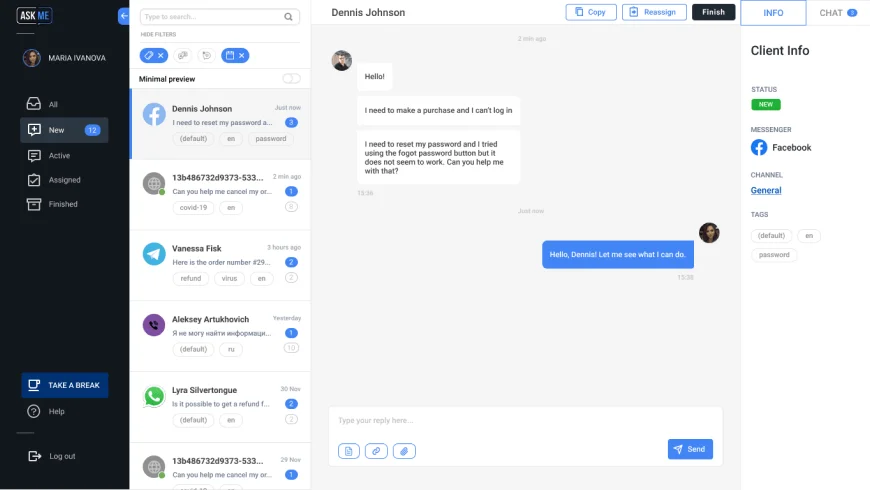ReactiveX is the proper method for concurrent eventualities in which declarative concurrency (such as scatter-gather) matters. The underlying Reactive Streams specification defines a protocol for demand, back pressure, and cancellation of knowledge pipelines with out limiting itself to non-blocking API or particular Thread utilization. And that’s what Project Loom makes use of under the hood to offer a virtual-thread-friendly implementation of sockets. The non-blocking I/O details are hidden, and we get a well-recognized, synchronous API. A full instance of using a java.internet.Socket instantly would take a lot of space, however when you’re curious here is an instance which runs multiple requests concurrently, calling a server which responds after three seconds.
There’s an fascinating Mastodon thread on precisely that subject by Daniel Spiewak. Daniel argues that because the blocking habits is totally different in the case of files and sockets, this shouldn’t be hidden behind an abstraction layer such as io_uring or Loom’s digital threads however as an alternative uncovered to the developer. That’s because their usage patterns should be completely different, and any blocking calls ought to be batched & protected using a gateway, such as with a semaphore or a queue. From the applying’s perspective, we get a non-blocking, asynchronous API for file access.
What Does This Imply To Common Java Developers?
So Spring is in pretty fine condition already owing to its giant neighborhood and extensive suggestions from existing concurrent functions. Project Loom is an open-source project that goals to supply help for lightweight threads called fibers in the Java Virtual Machine (JVM). Fibers are a new form of light-weight concurrency that may coexist with conventional threads in the JVM. They are a more environment friendly and scalable different to conventional threads for sure types of workloads. In this GitHub repository yow will discover a sample Spring software with the controller shown above. The README explains how to start the appliance and how to swap the controller from platform threads to digital threads.

While this received’t allow you to avoid thread pinning, you’ll have the ability to a minimal of identify when it occurs and if wanted, adjust the problematic code paths accordingly. Project Loom is still within the early levels of improvement and is not but obtainable in a manufacturing release of the JVM. However, it has the potential to significantly enhance the performance and scalability of Java purposes that depend on concurrency. When a fiber is blocked, for example, by ready for I/O, it can be scheduled to run one other fiber, this permits for a extra fine-grained management over concurrency, and might result in higher performance and scalability.
These mechanisms aren’t set in stone but, and the Loom proposal gives a good overview of the concepts involved. Read on for an summary of Project Loom and how it proposes to modernize Java concurrency. For these situations, we would have to carefully write workarounds and failsafe, placing all the burden on the developer.
Understanding Java’s Project Loom
Still, whereas code modifications to make use of virtual threads are minimal, Garcia-Ribeyro said, there are a few that some developers may have to make — particularly to older functions. The outcomes present that, typically, the overhead of making a model new virtual thread to process a request is less than the overhead of acquiring a platform thread from a thread pool. If you’d prefer to set an higher bound on the number of kernel threads utilized by your utility, you may now need to configure both the JVM with its carrier thread pool, as nicely as io_uring, to cap the utmost variety of threads it starts.
Make positive that you don’t, for instance, execute CPU-intensive computing duties on them, that they aren’t pooled by the framework, and that no ThreadLocals are saved in them (see also Scoped Value). The structured concurrency API can also be designed to preserve order in multi-threaded environments by treating multiple duties operating in particular person threads as a single logical unit of work. Without it, multi-threaded applications are extra error-prone when subtasks are shut down or canceled within the wrong order, and tougher to know, he mentioned. “Before Loom, we had two options, neither of which was actually good,” said Aurelio Garcia-Ribeyro, senior director of project management at Oracle, in a presentation at the Oracle DevLive convention this week.
It is likely to be attainable to reduce the competition in the usual thread pool queue, and improve throughput, by optimising the current implementations utilized by Tomcat. If you look closely, you may see InputStream.learn invocations wrapped with a BufferedReader, which reads from the socket’s input. That’s the blocking name, which causes the virtual thread to turn loom java into suspended. Using Loom, the take a look at completes in three seconds, even though we solely ever start sixteen platform threads in the whole JVM and run 50 concurrent requests. To implement digital threads, as mentioned above, a big part of Project Loom’s contribution is retrofitting existing blocking operations so that they’re virtual-thread-aware.
That way, when they’re invoked, they free up the carrier thread to make it potential for other virtual threads to renew. When these features are manufacturing ready, it shouldn’t have an result on common Java developers much, as these builders may be using libraries for concurrency use circumstances. But it can be a big deal in these uncommon scenarios where you’re doing lots of multi-threading with out utilizing libraries.
The conventional thread dumps printed through jcmd Thread.print don’t comprise virtual threads. The purpose for that is that this command stops the VM to create a snapshot of the running threads. This is possible for a quantity of hundred or even a few thousand threads, but not for tens of millions of them. In the second variant, Thread.ofVirtual() returns a VirtualThreadBuilder whose start() methodology starts a digital thread. The different technique Thread.ofPlatform() returns a PlatformThreadBuilder via which we are able to begin a platform thread. For example, if a request takes two seconds and we limit the thread pool to 1,000 threads, then a most of 500 requests per second could probably be answered.
Loom And The Means Ahead For Java
Almost every weblog submit on the primary page of Google surrounding JDK 19 copied the next text, describing digital threads, verbatim. Replacing synchronized blocks with locks inside the JDK (where possible) is another space that’s in the scope of Project Loom and what might be released in JDK 21. These changes are additionally what various Java and JVM libraries already applied or are within the strategy of implementing (e.g., JDBC drivers). The answer is to introduce some kind of virtual threading, where the Java thread is abstracted from the underlying OS thread, and the JVM can more effectively manage the connection between the 2.
- Asynchronous concurrency means you should adapt to a extra advanced programming style and deal with information races carefully.
- This will enhance efficiency and scalability generally based mostly on the benchmarks out there.
- At the end of the block, ExecutorService.close() is called, which in turn calls shutdown() and awaitTermination() – and possibly shutdownNow() should the thread be interrupted during awaitTermination().
- With the category HowManyVirtualThreadsDoingSomething you presumably can test how many digital threads you probably can run on your system.
- Structured concurrency might help simplify the multi-threading or parallel processing use circumstances and make them much less fragile and extra maintainable.
Another essential facet of Continuations in Project Loom is that they permit for a extra intuitive and cooperative concurrency mannequin. In conventional thread-based programming, threads are sometimes blocked or suspended because of I/O operations or different reasons, which may result in competition and poor performance. Continuations could be regarded as a generalization of the concept of a “stack frame” in traditional thread-based programming. They allow the JVM to characterize a fiber’s execution state in a extra light-weight and efficient means, which is necessary for attaining the efficiency and scalability benefits of fibers.
And then it’s your accountability to verify back once more later, to search out out if there’s any new information to be read. It’s worth noting that Fiber and Continuations usually are not supported by all JVMs, and the conduct may vary relying on the specific JVM implementation. Also, the usage of continuations might have some implications on the code, such as the potential for capturing and restoring the execution state of a fiber, which might have security implications, and must be used with care. When a fiber is created, a continuation object is also created to symbolize its execution state. When the fiber is scheduled to run, its continuation is “activated,” and the fiber’s code begins executing. When the fiber is suspended, its continuation is “captured,” and the fiber’s execution state is saved.
When we attempt to learn from a socket, we might have to attend till information arrives over the network. The state of affairs is completely different with recordsdata, which are learn from locally obtainable block devices. There, data is always available; it’d only be essential to copy the info from the disk to the memory.
For instance, threads which may be closely related might wind up sharing completely different processes, when they may benefit from sharing the heap on the same course of. Structured concurrency goals to simplify multi-threaded and parallel programming. It treats multiple tasks operating in several threads as a single unit of work, streamlining error handling and cancellation while enhancing reliability and observability. Being an incubator characteristic, this might undergo further modifications throughout stabilization. In this GitHub repository you can find several demo packages that show the capabilities of virtual threads.

Potentially, this may result in a model new supply of performance-related problems in our purposes, whereas fixing different ones. Loom and Java normally are prominently devoted to building web purposes. Obviously, Java is utilized in many other areas, and the concepts introduced by Loom could additionally be useful in quite a lot of purposes. It’s easy to see how massively rising thread effectivity and dramatically decreasing the useful resource requirements for handling multiple competing wants will result in greater throughput for servers.
Java’s concurrency utils (e.g. ReentrantLock, CountDownLatch, CompletableFuture) can be utilized on Virtual Threads with out blocking underlying Platform Threads. This change makes Future’s .get() and .get(Long, TimeUnit) good citizens on Virtual Threads and removes the necessity for callback-driven usage of Futures. Even although good,old Java threads and virtual https://www.globalcloudteam.com/ threads share the name…Threads, the comparisons/online discussions really feel a bit apple-to-oranges to me. With sockets it was straightforward, because you could just set them to non-blocking. But with file entry, there is no async IO (well, except for io_uring in new kernels).
